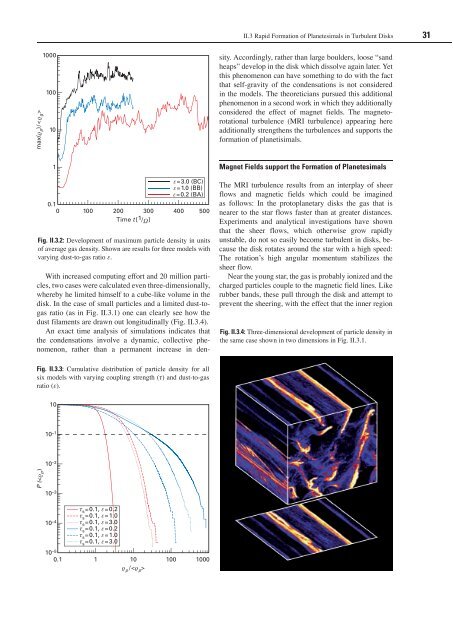Max Planck Institute for Astronomy - Annual Report 2007
Max Planck Institute for Astronomy - Annual Report 2007
Max Planck Institute for Astronomy - Annual Report 2007
You also want an ePaper? Increase the reach of your titles
YUMPU automatically turns print PDFs into web optimized ePapers that Google loves.
max( p )/< g ><br />
1000<br />
100<br />
10<br />
1<br />
0.1<br />
0<br />
100 200 300<br />
Time t [ 1 / ]<br />
=3.0 (BC)<br />
=1.0 (BB)<br />
=0.2 (BA)<br />
400 500<br />
Fig. II.3.2: Development of maximum particle density in units<br />
of average gas density. Shown are results <strong>for</strong> three models with<br />
varying dust-to-gas ratio e.<br />
With increased computing ef<strong>for</strong>t and 20 million particles,<br />
two cases were calculated even three-dimensionally,<br />
whereby he limited himself to a cube-like volume in the<br />
disk. In the case of small particles and a limited dust-togas<br />
ratio (as in Fig. II.3.1) one can clearly see how the<br />
dust filaments are drawn out longitudinally (Fig. II.3.4).<br />
An exact time analysis of simulations indicates that<br />
the condensations involve a dynamic, collective phenomenon,<br />
rather than a permanent increase in den-<br />
Fig. II.3.3: Cumulative distribution of particle density <strong>for</strong> all<br />
six models with varying coupling strength (t) and dust-to-gas<br />
ratio (e).<br />
P (< p )<br />
10<br />
10 –1<br />
10 –2<br />
10 –3<br />
10 –4<br />
10<br />
0.1<br />
–5<br />
s =0.1, =0.2<br />
s =0.1, =1.0<br />
s =0.1, =3.0<br />
s =0.1, =0.2<br />
s =0.1, =1.0<br />
s =0.1, =3.0<br />
1 10 100 1000<br />
p /< p ><br />
II.3 Rapid Formation of Planetesimals in Turbulent Disks 31<br />
sity. Accordingly, rather than large boulders, loose “sand<br />
heaps” develop in the disk which dissolve again later. Yet<br />
this phenomenon can have something to do with the fact<br />
that self-gravity of the condensations is not considered<br />
in the models. The theoreticians pursued this additional<br />
phenomenon in a second work in which they additionally<br />
considered the effect of magnet fields. The magnetorotational<br />
turbulence (MRI turbulence) appearing here<br />
additionally strengthens the turbulences and supports the<br />
<strong>for</strong>mation of planetisimals.<br />
Magnet Fields support the Formation of Planetesimals<br />
The MRI turbulence results from an interplay of sheer<br />
flows and magnetic fields which could be imagined<br />
as follows: In the protoplanetary disks the gas that is<br />
nearer to the star flows faster than at greater distances.<br />
Experiments and analytical investigations have shown<br />
that the sheer flows, which otherwise grow rapidly<br />
unstable, do not so easily become turbulent in disks, because<br />
the disk rotates around the star with a high speed:<br />
The rotation’s high angular momentum stabilizes the<br />
sheer flow.<br />
Near the young star, the gas is probably ionized and the<br />
charged particles couple to the magnetic field lines. Like<br />
rubber bands, these pull through the disk and attempt to<br />
prevent the sheering, with the effect that the inner region<br />
Fig. II.3.4: Three-dimensional development of particle density in<br />
the same case shown in two dimensions in Fig. II.3.1.

















